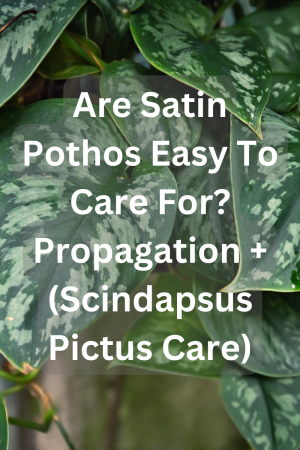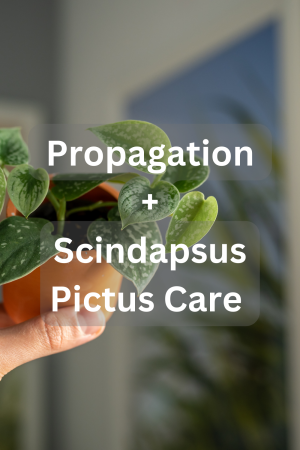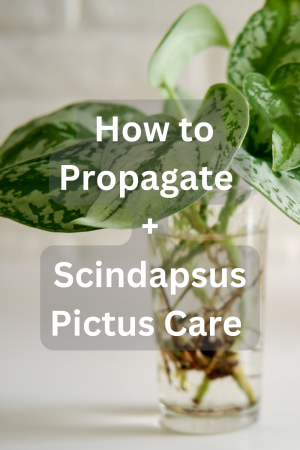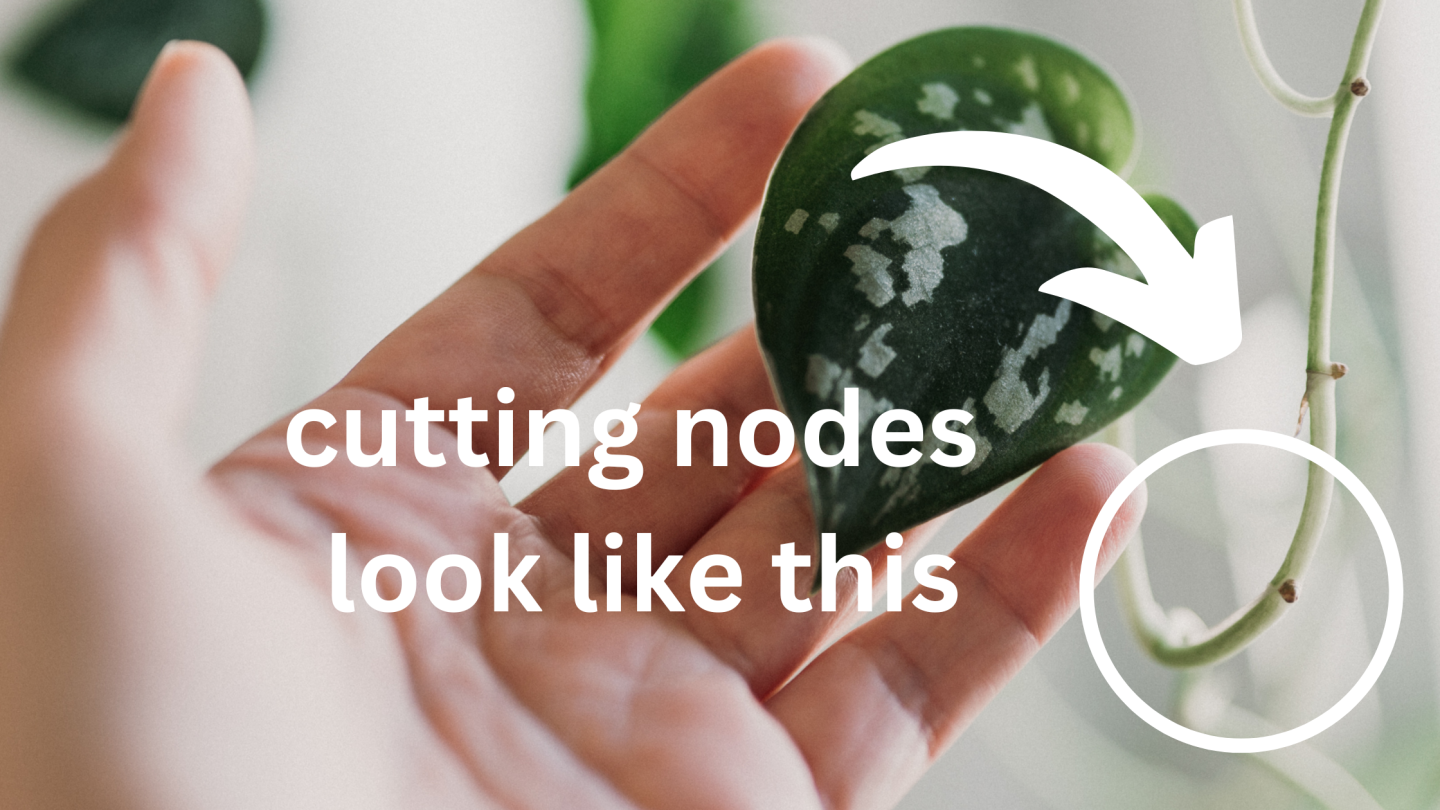
The Satin Pothos is one of my all time favorite plants! It’s absolutely beautiful houseplant. It really brightens up my space. I’m a huge fan of bring nature into the home and placing houseplants throughout my apartment is one way I do that. Anyways, let’s waste no time and get to the bottom of how to care for Satin Pothos.
Is Scindapsus Pictus a Pothos?
Scindapsus pictus is often confused with pothos (Epipremnum aureum) because they share similar appearances and growth habits. However, they are not the same plant species. Scindapsus pictus, also known as satin pothos or silver pothos, belongs to the genus Scindapsus, while pothos belongs to the genus Epipremnum. While they are related and both belong to the family Araceae, they are distinct species with some differences in leaf shape, texture, and growth patterns.
How often to Water Satin Pothos
Watering frequency for Satin Pothos (Scindapsus pictus) depends on various factors such as the size of the plant, the pot size, environmental conditions like temperature and humidity, and the type of soil. Here are some general guidelines to follow:
- Check Soil Moisture: Before watering, always check the moisture level of the soil. Stick your finger about an inch into the soil; if it feels dry, it’s time to water.
- Watering Frequency: Satin Pothos prefers slightly moist soil but does not like to sit in waterlogged conditions. Typically, watering once every 1-2 weeks should be sufficient. However, adjust the frequency based on how quickly the soil dries out in your specific environment.
- Watering Technique: When watering, thoroughly saturate the soil until water starts to drain from the bottom of the pot. Allow excess water to drain away completely, and never let the plant sit in standing water.
- Environmental Factors: During the warmer months or in environments with higher temperatures and lower humidity, you may need to water more frequently. Conversely, in cooler or less humid conditions, you may water less often.
- Observation: Pay attention to the condition of the plant. If the leaves start to droop or curl, it might be a sign that the plant needs water. However, be cautious not to overwater, as this can lead to root rot.
- Seasonal Variations: Adjust your watering schedule seasonally. Satin Pothos may require more frequent watering during the growing season (spring and summer) and less during the dormant period (fall and winter).
By monitoring the soil moisture and adjusting your watering routine accordingly, you can help ensure that your Satin Pothos remains healthy and thriving.

Soil Requirements for Scindapsus Pictus Houseplant
Satin Pothos (Scindapsus pictus) prefers a well-draining potting mix that retains some moisture but does not become waterlogged. Here are some soil requirements and recommendations for this houseplant:
- Well-Draining Soil: Use a high-quality, well-draining potting mix to prevent water from accumulating around the roots, which can lead to root rot. A mix formulated for houseplants or a blend of peat moss, perlite, and/or coarse sand works well.
- Moisture Retention: While Satin Pothos prefers well-draining soil, it also benefits from a soil mix that retains some moisture. This helps prevent the soil from drying out too quickly between waterings.
- pH Level: Satin Pothos thrives in slightly acidic to neutral soil with a pH range between 6.0 and 7.0. Most standard potting mixes fall within this pH range, but you can adjust the pH if necessary using soil amendments.
- Organic Matter: Adding organic matter like compost or well-rotted manure to the soil mix can provide nutrients and improve soil structure. However, avoid overdoing it, as too much organic matter can lead to compacted soil or drainage issues.
- Avoid Compacted Soil: Ensure that the soil remains loose and aerated to promote healthy root growth. Compacted soil can restrict root development and lead to various issues such as poor nutrient uptake and waterlogging.
- Container Size: Choose a pot with adequate drainage holes that allows excess water to escape easily. The size of the pot should accommodate the size of the plant’s root system with some room for growth.
- Fertilizer Considerations: While soil provides essential nutrients, you may need to supplement with occasional fertilization during the growing season. Use a balanced, water-soluble fertilizer formulated for houseplants, and follow the manufacturer’s instructions for application.
When repotting Satin Pothos, typically every 1-2 years or when the plant outgrows its current pot, refresh the soil to ensure optimal growing conditions. Additionally, monitor the soil moisture and adjust your watering routine as needed to maintain the health and vitality of your Satin Pothos houseplant.
Temperature requirements for Satin Pothos Houseplant
Satin Pothos (Scindapsus pictus) is a tropical plant native to Southeast Asia, so it thrives in warm and humid conditions. Here are the temperature requirements for Satin Pothos houseplants:
- Optimal Temperature Range: Satin Pothos prefers temperatures between 65°F to 85°F (18°C to 29°C) during the day. It can tolerate slightly cooler temperatures down to about 60°F (15°C) but may suffer if exposed to prolonged cold or frost.
- Avoid Temperature Extremes: Protect Satin Pothos from extreme temperature fluctuations, as sudden drops in temperature can stress the plant and affect its growth. Avoid placing it near drafty windows, doors, or heating/cooling vents.
- Winter Care: During the winter months, when indoor heating can dry out the air, maintain a minimum temperature of around 60°F (15°C) to keep the plant comfortable. Satin Pothos may tolerate slightly cooler temperatures at night, but it’s best to avoid prolonged exposure to temperatures below 55°F (13°C).
- Humidity: While Satin Pothos can adapt to average household humidity levels, it appreciates higher humidity levels, mimicking its natural tropical habitat. You can increase humidity by misting the leaves regularly, placing a humidifier nearby, or using pebble trays filled with water beneath the plant’s pot.
- Avoid Cold Drafts: Protect Satin Pothos from cold drafts, especially during the winter months. Cold drafts can cause damage to the leaves and slow down growth.
- Temperature Tolerance: Satin Pothos is not frost-tolerant and should be kept indoors in cooler climates or brought indoors during colder months. Even brief exposure to temperatures below 50°F (10°C) can cause damage to the plant.
Overall, providing consistent temperatures within the recommended range, along with adequate humidity, will help ensure the health and vitality of your Satin Pothos houseplant. Pay attention to its response to environmental conditions and make adjustments as needed to maintain optimal growing conditions.

Do Satin Pothos Cry? Water Droplets on my Satin Pothos?
The phenomenon of water droplets appearing on the leaves of plants, often mistaken for tears or crying, is called guttation. However, guttation typically occurs in plants with specialized structures called hydathodes, which are found in certain plant species but not in Satin Pothos (Scindapsus pictus).
The appearance of water droplets on the leaves of Satin Pothos is more likely due to a different phenomenon called guttation, which occurs when the plant takes in water through its roots faster than it can transpire it through its leaves. This excess water can be expelled through small openings or pores in the leaves called stomata or through damaged areas in the leaf tissue.
The presence of water droplets on the leaves of Satin Pothos is generally harmless and is not an indication of any issues with the plant. It’s a natural process that occurs under certain environmental conditions, such as high humidity or when the plant has absorbed excess water. If you notice water droplets on your Satin Pothos, it’s generally nothing to be concerned about, but it might be a sign to adjust your watering routine to prevent overwatering.
Do Satin Pothos Like Humidity
Yes, Satin Pothos (Scindapsus pictus) does appreciate higher humidity levels, as it is native to tropical regions where humidity tends to be higher. While Satin Pothos can adapt to average household humidity levels, providing it with increased humidity can promote healthier growth and more vibrant foliage.
Here are some ways to increase humidity for your Satin Pothos:
- Misting: Regularly misting the leaves with water can increase humidity around the plant. However, misting may not be sufficient to significantly raise humidity levels in drier environments.
- Humidifiers: Using a humidifier in the room where your Satin Pothos is located can help maintain higher humidity levels. Position the humidifier nearby, but avoid placing it too close to prevent waterlogging the plant or its soil.
- Pebble Trays: Place the pot on a tray filled with pebbles and water. As the water evaporates, it creates moisture in the air around the plant. Ensure that the bottom of the pot does not touch the water to prevent water uptake through the drainage holes, which can lead to overwatering.
- Grouping Plants: Grouping several houseplants together can create a microclimate with higher humidity levels due to the collective transpiration of moisture from the plants’ leaves.
- Bathroom or Kitchen: Placing your Satin Pothos in the bathroom or kitchen, where humidity levels are naturally higher due to activities like showering or cooking, can also benefit the plant.
While Satin Pothos can tolerate average indoor humidity levels, providing it with increased humidity can enhance its overall health and appearance, promoting lush foliage and vigorous growth. However, be cautious not to create excessively humid conditions, as this can also lead to issues such as fungal growth or root rot. Monitor the plant’s response and adjust humidity levels accordingly.
More plant posts
Nurturing Growth: A Complete Guide to Successful Plant Repotting
Exploring the Wonders of Monstera: Your Ultimate Guide
Secrets of the Elephant Ear Houseplant Alocasia Plant Guide
Learn How to Care for the Philodendron Brasil (Happy Plant)
Light Requirements for Satin Pothos Houseplant
Satin Pothos (Scindapsus pictus) is a versatile houseplant that can adapt to a range of light conditions, but it does best in moderate to bright, indirect light. Here are some guidelines for providing the appropriate light for your Satin Pothos:
- Indirect Light: Satin Pothos prefers bright, indirect light. Direct sunlight can scorch its leaves, so it’s best to place it in a location where it receives filtered light or is shaded from direct sun, such as near a north or east-facing window. If placing it near a south or west-facing window, ensure that it is shielded by sheer curtains or placed further away from the window to avoid direct sunlight exposure.
- Low Light Tolerance: While Satin Pothos prefers bright, indirect light, it can also tolerate lower light conditions. It may survive in low-light environments, but growth may be slower, and the foliage may become less variegated.
- Avoid Direct Sunlight: Direct sunlight can cause the leaves of Satin Pothos to become scorched or faded. If you notice the leaves turning yellow or developing brown spots, it may be a sign that the plant is receiving too much direct sunlight.
- Consistent Light: Aim to provide consistent light conditions for your Satin Pothos. Avoid placing it in areas with extreme light fluctuations, such as near drafty windows or heat vents, as this can stress the plant.
- Rotate the Plant: To ensure even growth and prevent the plant from leaning towards the light source, rotate the pot occasionally to expose all sides of the plant to light.
- Artificial Lighting: If natural light is limited in your space, you can supplement with artificial grow lights. Choose full-spectrum LED lights designed for houseplants and adjust the distance and duration of lighting based on the plant’s response.
Overall, providing moderate to bright, indirect light is ideal for Satin Pothos to thrive. By observing the plant’s response and adjusting its placement accordingly, you can ensure that it receives the appropriate amount of light for healthy growth and vibrant foliage.
Satin Pothos Acidity
Satin Pothos (Scindapsus pictus) generally prefers slightly acidic to neutral soil conditions. When discussing the acidity of soil, pH is the measurement used to indicate the soil’s acidity or alkalinity. The pH scale ranges from 0 to 14, with 7 being considered neutral. Values below 7 are acidic, while values above 7 are alkaline.
For Satin Pothos:
- The ideal pH range for soil is typically between 6.0 and 7.0, which is slightly acidic to neutral. This pH range allows the plant to efficiently absorb nutrients from the soil.
- Satin Pothos can tolerate slightly lower or higher pH levels, but extreme acidity or alkalinity can hinder nutrient uptake and affect the plant’s overall health.
When potting or repotting Satin Pothos, it’s essential to use a well-draining potting mix with a pH within the preferred range. Standard potting mixes formulated for indoor plants often fall within this range, but it’s always a good idea to check the pH of the soil if you’re uncertain.
You can measure soil pH using a soil pH meter or test kit, which are readily available at garden centers or online. If the soil pH is outside the preferred range for Satin Pothos, you can adjust it by amending the soil with pH-adjusting products or additives. However, drastic pH adjustments should be done gradually to avoid shocking the plant’s roots.
Overall, maintaining slightly acidic to neutral soil conditions is key to ensuring the health and vitality of your Satin Pothos houseplant. Regular monitoring of soil pH and providing appropriate care will help promote optimal growth and foliage coloration.
Fertilizer Methods for the Satin Pothos
Fertilizing Satin Pothos (Scindapsus pictus) is essential for promoting healthy growth and vibrant foliage. Here are some methods and guidelines for fertilizing your Satin Pothos:
- Choose the Right Fertilizer: Use a balanced, water-soluble fertilizer formulated for houseplants. Look for a fertilizer with a balanced NPK ratio, such as 10-10-10 or 20-20-20, which provides equal proportions of nitrogen (N), phosphorus (P), and potassium (K), along with essential micronutrients.
- Frequency: During the growing season in spring and summer, fertilize your Satin Pothos approximately every 4-6 weeks. Reduce or suspend fertilization during the fall and winter months when the plant’s growth slows down.
- Dilution: Follow the manufacturer’s instructions for diluting the fertilizer in water. It’s crucial not to exceed the recommended dosage, as overfertilizing can lead to salt buildup in the soil, which can damage the plant’s roots.
- Application Method: There are several methods for applying fertilizer to Satin Pothos:
- Liquid Fertilizer: Mix the fertilizer with water according to the instructions on the label, then water the plant with the solution. Ensure that the soil is moist before applying the fertilizer to prevent root burn.
- Foliar Feeding: You can also apply diluted fertilizer directly to the foliage by spraying it onto the leaves. This method allows the plant to absorb nutrients through the leaves’ stomata.
- Soil Drench: Pour the diluted fertilizer directly onto the soil around the base of the plant. Water thoroughly to distribute the fertilizer evenly throughout the root zone.
- Flush the Soil: Periodically flush the soil with plain water to remove any excess salts that may have accumulated from fertilization. This helps prevent salt buildup, which can cause root damage and hinder nutrient uptake.
- Monitor the Plant: Pay attention to how your Satin Pothos responds to fertilization. If you notice signs of fertilizer burn (such as leaf tip burn or wilting), reduce the frequency or strength of fertilization.
- Adjustments: Consider adjusting your fertilization routine based on the plant’s growth and health. If the plant is growing vigorously and producing abundant foliage, you may continue with regular fertilization. However, if growth is slow or the leaves appear pale, you may need to increase the frequency or strength of fertilization.
By following these fertilization methods and guidelines, you can help ensure that your Satin Pothos receives the nutrients it needs for healthy growth and lush foliage.

Where to Cut Scindapsus Pictus to Propagate?
To propagate a satin pothos (Scindapsus pictus), you’ll want to take stem cuttings. Here’s a step-by-step guide on where and how to cut for propagation:
- Choose Healthy Vines: Select a healthy vine from the parent plant that you want to propagate. Look for a stem that has several leaves on it.
- Locate a Node: Nodes are the points on the stem where leaves emerge. They are crucial for root development. Look for a node that’s located between two leaves.
- Make the Cut: Using clean, sharp scissors or pruning shears, make a clean cut directly below the node. Ensure the cutting is about 4-6 inches in length. The node should be at the bottom end of the cutting.
- Remove Lower Leaves (Optional): You can remove one or two of the lower leaves from the cutting. This reduces the moisture loss from the leaves and directs more energy towards root development.
- Rooting Hormone (Optional): Some people like to dip the cut end of the stem in rooting hormone powder to encourage faster root growth, but this step is optional.
- Place in Water or Soil: You can propagate satin pothos cuttings either in water or directly in soil. If propagating in water, place the cut end of the stem in a jar or glass of water, ensuring that the node is submerged. If propagating in soil, plant the cutting in a small pot filled with well-draining potting mix, ensuring that the node is buried in the soil.
- Provide Adequate Care: Place the cutting in a location with bright, indirect light and keep the soil consistently moist (if propagating in soil) or change the water regularly (if propagating in water).
- Monitor and Wait: Roots should start to develop in a few weeks. Once the roots are a couple of inches long and the cutting has established some new growth, you can transplant it into a larger pot with regular potting soil.

More plant posts
Nurturing Growth: A Complete Guide to Successful Plant Repotting
Exploring the Wonders of Monstera: Your Ultimate Guide
Secrets of the Elephant Ear Houseplant Alocasia Plant Guide
Learn How to Care for the Philodendron Brasil (Happy Plant)
Falling leaves on the Satin Pothos
If you’re experiencing falling leaves on your Satin Pothos (Scindapsus pictus), there could be several reasons behind this issue. Here are some common causes and solutions:
- Overwatering or Underwatering: Both overwatering and underwatering can lead to leaf drop in Satin Pothos. Ensure that you’re watering your plant appropriately. Allow the top inch or so of the soil to dry out between waterings, and water thoroughly when you do water. Avoid letting the plant sit in waterlogged soil.
- Improper Lighting: Satin Pothos prefers bright, indirect light. If it’s receiving too much direct sunlight or insufficient light, it may drop leaves. Adjust the plant’s placement to ensure it’s getting the right amount of light.
- Temperature Stress: Extreme temperature fluctuations or exposure to cold drafts can cause stress and lead to leaf drop. Ensure that your Satin Pothos is not placed near heating or cooling vents, and avoid sudden temperature changes.
- Nutrient Deficiency: If your plant lacks essential nutrients, it may drop leaves. Consider fertilizing your Satin Pothos with a balanced houseplant fertilizer according to the recommended schedule. Ensure that the soil pH is within the optimal range for Satin Pothos (slightly acidic to neutral).
- Pests or Diseases: Check your plant for signs of pests such as spider mites, mealybugs, or scale insects, as well as any signs of disease. Treat any pest infestations promptly with appropriate methods, such as insecticidal soap or neem oil. Prune away any diseased or damaged foliage.
- Transplant Shock: If you recently repotted or propagated your Satin Pothos, it may experience some leaf drop due to transplant shock. Ensure that the plant is receiving proper care and give it time to adjust to its new environment.
- Seasonal Changes: It’s normal for some leaf drop to occur seasonally, especially in the fall or winter months when plants may go through a period of dormancy or reduced growth. As long as new growth is appearing, some leaf drop is natural and not necessarily a cause for concern.
By addressing these potential issues and providing appropriate care for your Satin Pothos, you can help prevent further leaf drop and promote a healthy, thriving plant. If you’re unsure about the cause of the leaf drop or if the problem persists, consider consulting with a local plant expert or horticulturist for further assistance.
Do Satin Pothos Houseplants Purify the Air?
Yes, Scindapsus pictus is known to be an air-purifying houseplant. Like many other plants, Satin Pothos has the ability to remove certain pollutants from the air through a process called phytoremediation.
Specifically, Satin Pothos can help remove common indoor air pollutants such as formaldehyde, benzene, xylene, and toluene. These pollutants can be emitted by various household items such as furniture, carpets, paint, and cleaning products.
In addition to purifying the air, Satin Pothos also contributes to improving indoor air quality by releasing oxygen during photosynthesis and increasing humidity levels around the plant.
While no single plant can completely purify the air in a room on its own, incorporating air-purifying plants like Satin Pothos into indoor spaces can complement other air quality improvement strategies such as proper ventilation and minimizing the use of pollutants indoors.

Is Satin Pothos Plants Toxic?
Yes, Satin Pothos (Scindapsus pictus) is toxic to pets and humans if ingested. Like many other plants in the Araceae family, including other Pothos varieties, Satin Pothos contains calcium oxalate crystals. These crystals can cause irritation and discomfort if they come into contact with the mouth, throat, or digestive tract.
Symptoms of ingestion may include oral irritation, drooling, difficulty swallowing, vomiting, and in severe cases, swelling of the mouth and throat, which can potentially lead to difficulty breathing.
Therefore, it’s important to keep Satin Pothos out of reach of children and pets, and to educate household members about the potential dangers of ingesting parts of the plant. If you suspect that ingestion has occurred or if someone exhibits symptoms after contact with the plant, seek medical or veterinary attention immediately.
While Satin Pothos can add beauty to indoor spaces, it’s essential to enjoy it responsibly and take appropriate precautions to ensure the safety of pets and family member
